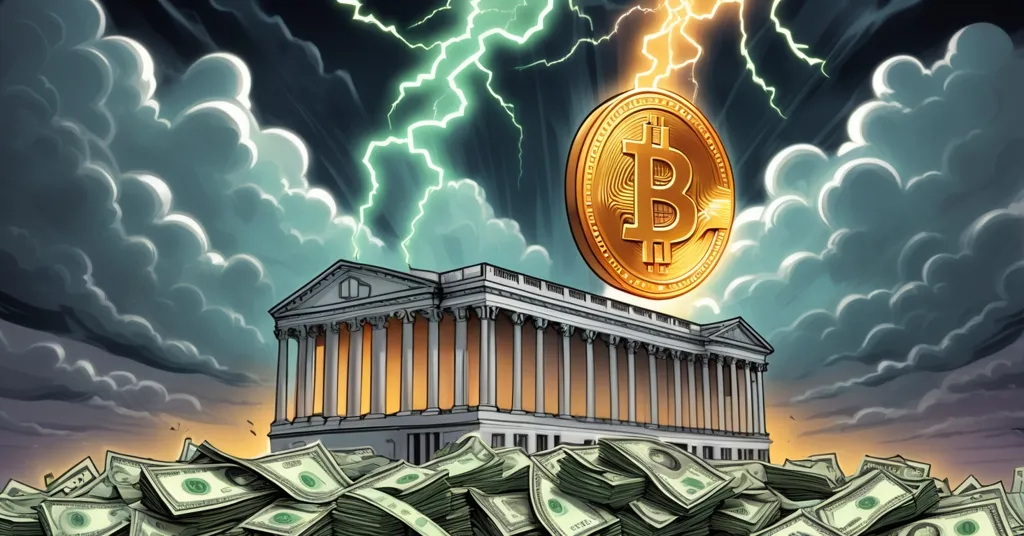Trump’s $2,000 Stimulus: Will It Fuel a Bitcoin Surge by 2026 or Fizzle Out?

Trump’s $2,000 Stimulus Checks: Can They Ignite a Bitcoin and Crypto Surge by 2026?
President Trump’s recent proposal for $2,000 stimulus checks—branded as “tariff dividends”—has sparked heated debate in the crypto community. Could this cash infusion, aimed at American families earning under $100,000, trigger a retail buying frenzy akin to the 2020 Bitcoin and Ethereum booms, or is it merely political hot air unlikely to materialize?
- Stimulus Plan: Trump’s $2,000 checks, potentially funded by tariff revenue, are slated for mid-2026 at the earliest.
- Past Impact: The 2020 CARES Act stimulus drove massive crypto gains, with Bitcoin up 900% in a year.
- Obstacles: Legal battles, funding shortfalls, and congressional delays throw the plan into serious doubt.
Understanding the Proposal: Tariff Dividends and Political Promises
Let’s get straight to the core of this buzz. Trump, alongside treasury officials, has pitched a direct payment of at least $2,000 per person as a “tariff dividend”—a payout derived from taxes imposed on imported goods. The idea is to offset the economic sting of tariffs by redistributing the revenue to everyday Americans, specifically targeting households with incomes below $100,000. This concept gained legislative momentum with Senator Josh Hawley’s American Worker Rebate Act, introduced in July 2025, which aims to channel tariff collections into rebate checks. However, Trump has already dampened expectations, stating these payments won’t hit bank accounts until mid-2026 at the earliest, ruling out any holiday windfall for 2025.
For the crypto crowd, the announcement—however distant—stirs memories of past government handouts supercharging digital asset markets. But before we get carried away with visions of Bitcoin breaking new highs, we need to dissect whether this plan has legs or if it’s just another campaign trail carrot dangled before a weary electorate. For more insights on the potential impact, check out this analysis on Trump’s stimulus proposal and its effect on crypto markets.
Lessons from 2020: When Stimulus Fueled Crypto Rocket Fuel
Rewind to 2020, when the CARES Act dropped $1,200 per adult and $500 per child into American wallets amid the COVID-19 meltdown. The result? A retail-driven crypto explosion. Bitcoin surged over 50% in just five weeks post-stimulus and a staggering 900% within a year. Ethereum, the blockchain powering decentralized apps and smart contracts (think self-executing digital agreements), skyrocketed from $120 to a peak of $4,800. The total crypto market capitalization ballooned from $180 billion to over $3 trillion. Exchange data from that era showed clear patterns—many $1,200 deposits translated directly into Bitcoin buys, as everyday folks, not just traders, jumped into the market.
This wasn’t just about the big players. The 2020 stimulus sparked what many call an “altcoin season,” where smaller, often speculative cryptocurrencies beyond Bitcoin and Ethereum rode a wave of retail FOMO—fear of missing out. Newcomers, flush with government cash, experimented with decentralized finance (DeFi) platforms and digital collectibles like NFTs, non-fungible tokens that represent unique digital assets. It was chaos, sure, but also a gateway for millions to grasp the potential of blockchain technology.
Could a $2,000 check replicate this magic? Possibly. Bitcoin, often viewed as a hedge against inflation due to its fixed supply of 21 million coins, would likely be the first stop for fresh capital. Ethereum could see inflows too, given its role as the backbone of much of Web3 innovation. Even altcoins might get a lift if retail hype kicks in—though their wild price swings are a gamble not everyone’s stomach can handle. But let’s not pop the champagne yet; the headwinds against this stimulus are fierce.
Roadblocks Ahead: Why $2,000 Might Never Hit Your Wallet
Here’s where the cold water gets splashed. The funding for these checks hinges on tariff revenue—taxes on imported goods—which sounds neat until you run the numbers. By mid-2025, the U.S. collected $122 billion in tariffs, with projections hitting $300 billion for the year under current policies. Now compare that to the cost: a blanket $2,000 stimulus could run upwards of $600 billion annually. Even a targeted rollout to 150 million people under the income threshold still costs around $300 billion, nearly draining the entire tariff pot. So, what fills the gap? Borrowing through U.S. Treasury bonds, Federal Reserve money printing, or burdening future taxpayers with skyrocketing debt interest. None of these scream “sustainable,” and all carry inflationary risks—a bittersweet pill for crypto, which thrives on inflation fears but could stumble if economic chaos spooks risk-averse investors.
Then there’s the legal mess. Trump’s tariffs, enacted under the International Emergency Economic Powers Act (IEEPA), are under fire in the U.S. Supreme Court. The court’s “major questions” doctrine—a principle questioning whether a president can make sweeping economic moves without explicit congressional approval—could gut Trump’s tariff authority. If that happens, the funding spine of this stimulus plan collapses faster than a ponzi token on a bad day. Add to this the gridlock of congressional approval—lawmakers agreeing on anything by 2026 is about as likely as a snail winning a sprint—and the timeline feels more like wishful thinking than policy reality.
Decentralized prediction markets aren’t buying the hype either. Polymarket, a platform where users wager crypto on real-world outcomes, pegs just a 1% chance of Americans seeing these checks by the end of 2025. Social media, meanwhile, is a mixed bag of overhyped noise. Take this post from The Kobeissi Letter on November 9, 2025:
BREAKING: President Trump announces that he will be paying a ‘tariff dividend’ of at least $2,000 per person. Stimulus checks are officially back.
Or this gem from Alex Mason on November 3, 2025:
The FED printed $7.75 billion today, bringing the total to $37 billion printed in the last few days. This is the biggest money printing event of the last 5 years. The crypto market is about to go parabolic.
Let’s call this what it is: baseless speculation that’s more about pumping bags than informing anyone. There’s no hard link between current Fed actions and this specific stimulus plan, and “parabolic” is just code for “I have no data, but trust me.” We’re here for facts, not fantasies. While money printing could indeed boost markets by devaluing fiat, it’s far from a done deal, and the crypto space isn’t the Wild West of 2020 anymore. Institutional players—hedge funds, corporate treasuries, and Bitcoin ETFs—now dominate much of the liquidity, dulling the impact of retail surges.
Crypto’s Fate: Boom or Bust Without Handouts?
So, what if these checks never materialize? Crypto isn’t going to curl up and die. We’d likely see a slower, more measured bull market. Bitcoin dominance—its share of the total crypto market value—could rise as investors cling to the safest harbor in choppy waters. Altcoin seasons, those euphoric bursts where smaller coins spike on pure hype, might fizzle without retail cash flooding the gates. Instead, institutional flows would steer the ship, delivering steadier growth but lacking the fireworks of 2020’s retail mania. Stablecoins, cryptocurrencies pegged to fiat like the U.S. dollar for low-volatility trading, could see heavy accumulation as investors park funds, waiting for clearer signals.
But let’s flip the script: institutional dominance isn’t all sunshine. It could price out smaller retail players, the lifeblood of grassroots adoption, or stifle innovation in riskier altcoin projects that don’t fit Wall Street’s risk profile. And unlike 2020, the 2026 crypto landscape might face tighter regulations—think stricter KYC (know your customer) rules or tax reporting—that could dampen retail enthusiasm even if checks arrive. Plus, global reactions matter. A U.S. stimulus-driven rally might push Europe or Asia to clamp down on crypto, fearing capital flight, which could hit miners or cross-border projects hardest.
Zooming out, the crypto market’s maturity means a $2,000 check won’t pack the same punch as before. Bitcoin ETFs have opened the door to mainstream investors, corporate balance sheets hold digital assets, and central bank digital currency (CBDC) discussions loom large. These factors shift the game from retail FOMO to systemic integration—great for long-term stability, less so for moonshot hype. If anything, a stimulus flop could reinforce Bitcoin’s narrative as a fiat alternative, especially if inflation spikes from half-baked funding schemes.
The Bigger Picture: Why Decentralization Still Wins
Here’s the kicker, and why I lean Bitcoin maximalist even while appreciating Ethereum’s utility and altcoin niches: stimulus checks, even if they happen, are a symptom of a broken system. Bitcoin was forged in the ashes of the 2008 financial crisis, a middle finger to centralized control, endless money printing, and bailouts for the elite. Government handouts might nudge adoption—more people buying BTC or ETH is never bad—but they’re still fiat crutches. The real revolution is in rendering such dependency obsolete. Crypto’s fixed supply (Bitcoin’s 21 million cap) and decentralized ethos are the antidote to policymakers playing god with your purchasing power.
Whether checks land or not, the mission doesn’t waver. If they do, we might see a short-term price bump and a wave of newbies joining the fold—perfect for spreading the gospel of financial sovereignty. If they don’t, crypto grinds on, proving its worth outside government whims. Hell, a failed stimulus might even drive more folks to Bitcoin as trust in fiat erodes further. Either way, the blockchain train keeps rolling.
What It Means for You: Navigating Stimulus Uncertainty in Crypto
Let’s wrap this with practical takeaways. Regardless of political promises, crypto’s volatility isn’t going anywhere. Diversify across Bitcoin and stablecoins to hedge wild swings—don’t bet your life savings on a policy roll of the dice. Stay skeptical of “parabolic” predictions; they’re often noise from folks with agendas. And remember, every government fumble is a reminder of why we’re here: to build a system where your money answers to you, not D.C. drama.
Key Questions and Takeaways on Trump’s Stimulus and Crypto Impact
- What are Trump’s proposed $2,000 stimulus checks?
They’re “tariff dividend” payments of at least $2,000 per person, aimed at families earning under $100,000, meant to be funded by revenue from taxes on imported goods, as pitched by Trump and his treasury team. - How likely are these checks to roll out by 2026?
Chances look slim with funding gaps, legal challenges in the Supreme Court over tariff authority, and congressional hurdles—Polymarket bets just 1% odds by end of 2025, with mid-2026 as the earliest hope. - What did past stimulus mean for crypto markets?
The 2020 CARES Act’s $1,200 payments fueled retail buying, lifting Bitcoin 50% in five weeks and 900% in a year, Ethereum from $120 to $4,800, and the market cap past $3 trillion. - Could a 2026 stimulus ignite another Bitcoin and crypto surge?
If issued, it could spark a short-term retail rush into Bitcoin and major altcoins, though tighter regulations and market maturity might cap the frenzy compared to 2020’s wildfire gains. - What happens to crypto if no stimulus checks arrive?
Expect slower rallies, stronger Bitcoin dominance, weaker altcoin hype, and a market propped by institutional steadiness rather than retail euphoria—less boom, more grind. - What are the main funding challenges for these checks?
Tariff revenue, projected at $300 billion for 2025, may not cover the $300-600 billion price tag, pushing reliance on borrowing, Fed printing, or future tax hits—all risky moves with inflationary blowback. - Why are Trump’s tariffs under legal fire?
Enacted via the IEEPA, they’re challenged in the Supreme Court under the “major questions” doctrine, which asks if such big economic plays need a clear congressional thumbs-up.
Bottom line? A $2,000 stimulus could jolt crypto adoption and prices short-term, but the odds of it happening are shaky at best. Legal walls, fiscal math, and political games stand in the way. Yet crypto’s strength isn’t in waiting for handouts—it’s in outgrowing the need for them. Stack your sats, keep your eyes peeled, and bet on decentralization over D.C. promises any day. The real surge isn’t in a check; it’s in a future where finance bows to no one.



